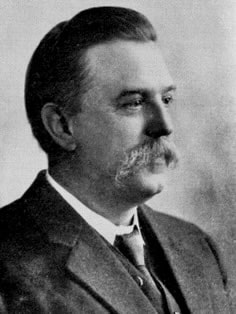T. Kennedy Dalziel

Thomas Kennedy Dalziel (1861–1924) was a Scottish surgeon and pathologist.
Dalziel was a Scottish abdominal surgeon, pathologist, and educator, best remembered for his 1913 description of chronic interstitial enteritis—a disease with features identical to what is now known as Crohn’s disease.
He combined a remarkable technical skill with humanistic medical teaching and was instrumental in the growth of children’s surgery and hospital infrastructure in Glasgow. Knighted for his services during World War I, Dalziel’s contributions straddled surgery, academia, and national service.
Biography
- 1861 – Born at Merkland, Penpont, Dumfriesshire, Scotland
- 1883 – Graduated MB CM from the University of Edinburgh Medical School
- 1884–1885 – Studied experimental surgery and pathology in Berlin and Vienna
- 1885 – Returned to Glasgow as house surgeon at Glasgow Royal Infirmary; succeeded Sir William Macewen as casualty surgeon
- 1887 – Elected Fellow of the Faculty of Physicians and Surgeons of Glasgow (F.R.F.P.S.G.)
- 1888 – Appointed extra honorary surgeon to the Dispensary of the Royal Hospital for Sick Children
- 1889 – Joined Western Infirmary as assistant to Sir Hector Clare Cameron
- 1891 – Appointed Professor of Medical Jurisprudence, Anderson’s College, Glasgow
- 1892 – Promoted to visiting surgeon at Royal Hospital for Sick Children, Glasgow
- 1893 – Became Dean of the Medical Faculty, Anderson’s College
- 1895 – Appointed Professor of Surgery, Anderson’s College
- 1902 – Appointed Visiting Surgeon at Western Infirmary
- 1905 – Performed first recorded surgery on patient with “hyperplastic enteritis”
- 1908 – Joined Territorial Medical Service
- 1911 – Appointed Justice of the Peace for Glasgow
- 1913 – Presented lecture and landmark paper on “Chronic Interstitial Enteritis” describing nine cases
- 1914 – Resigned as RHSC visiting surgeon; became Consulting Surgeon
- 1916 – Appointed to the Advisory Council of the Director-General, RAMC; inspected hospitals in France
- 1917 – Knighted for wartime service and professional distinction
- 1921 – Joined Board of Directors, Royal Hospital for Sick Children
- 1924 – Died February 10 in Glasgow, aged 63
Except Sir Hector Cameron, who is fortunately still with us, no surgeon in the West of Scotland has filled so great a place in the estimation of the public as Sir Kennedy Dalziel, or filled it so adequately
Key Contributions
Chronic Interstitial Enteritis: Dalziel’s Forgotten Legacy
In 1913, Dalziel presented a paper on a series of nine patients suffering from a condition he described as chronic interstitial enteritis. His clinical observations, pathological descriptions, and surgical interventions outlined the hallmarks of what would later be termed Crohn’s disease by Burrill B. Crohn and colleagues in 1932.
Dalziel noted features such as eosinophilic infiltration, granulomas, and bowel wall thickening—decades before their formal association with inflammatory bowel disease. Although his work fell into obscurity, it has since been recognized as a pioneering contribution in gastroenterology.
He read his paper on ‘Chronic Interstitial Enteritis‘ at the Annual B.M.A. Conference at Brighton. He presented nine cases of chronic interstitial enteritis with granulomas, distinguishing the condition from tuberculosis and concluded:
As far as I am aware the disease has not been previously described, but it seems probable that many cases must have been seen and have been diagnosed as tuberculous.
Dalziel and the Royal Hospital for Sick Children
Dalziel was deeply committed to paediatric surgery. From his early role as honorary dispensary surgeon in 1888 to his appointment as consulting surgeon in 1914, he shaped care at the Royal Hospital for Sick Children in Glasgow. He championed the construction of the new hospital at Yorkhill, completed just before World War I. His continued advocacy for children’s health led to his role on the Board of Directors in 1921, ensuring long-term strategic improvements.
Surgery, Service, and Knighthood: A Life Beyond the Operating Room
Beyond his surgical brilliance, Dalziel was a public servant and wartime leader. As Lieutenant-Colonel in the Territorial Medical Service, he directed the 3rd General Hospital at Stobhill during World War I and was later tasked with inspecting field hospitals in France. His organisational skill and medical leadership were pivotal during the war, earning him a knighthood in 1917. Known for his teaching, dexterity, and compassion, Dalziel left a legacy that spanned clinical excellence and national service.
Major Publications
- Dalziel TK. Chronic Interstitial Enteritis. Br Med J 1913; 2: 1068-1070. [Crohn’s disease]
- Dalziel TK. Practical Points in Abdominal Surgery, Being the “James Watson Lectures” Delivered before the Royal Faculty of Physicians and Surgeons, 11th and 14th March, 1913. Glasgow Med J. 1914 Sep;82(3):161-182; 249-262; 338-349
- Dalziel K. Surgical Kidney. Glasgow Med J. 1922 Feb;97(2):90-97.
References
Biography
- Sir T. Kennedy Dalziel. Glasgow Med J. 1924 Mar;101(3):154–6.
- Sir Thomas Kennedy Dalziel, M.B., C.M.Edin., F.R.F.P.S.Glasg. Br Med J. 1924 Feb 23;1(3295):356.
- Sir Kennedy Dalziel. Lancet 1924; 203(5242): 362-363
- Young DG. Sir T Kennedy Dalziel MB, CM, FFPS (1861-1924). HHARP
Eponymous terms
- Fielding JF. Crohn’s disease and Dalziel’s syndrome. A history. J Clin Gastroenterol. 1988; 10(3): 279‐285.
- Dalziel TK. Thomas Kennedy Dalziel 1861-1924. Chronic interstitial enteritis. Dis Colon Rectum. 1989 Dec;32(12):1076-8.
- Mulder DJ, Noble AJ, Justinich CJ, Duffin JM. A tale of two diseases: the history of inflammatory bowel disease. J Crohns Colitis. 2014 May;8(5):341-8.
Eponym
the person behind the name
BA MA (Oxon) MBChB (Edin) FACEM FFSEM. Emergency physician, Sir Charles Gairdner Hospital. Passion for rugby; medical history; medical education; and asynchronous learning #FOAMed evangelist. Co-founder and CTO of Life in the Fast lane | On Call: Principles and Protocol 4e| Eponyms | Books |
